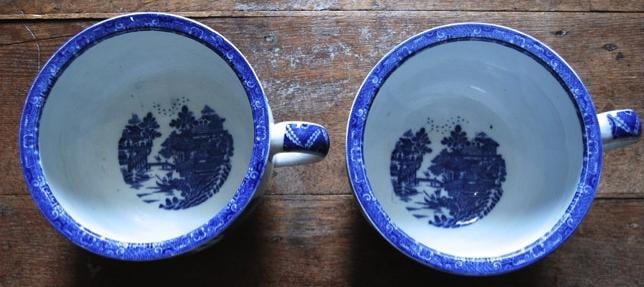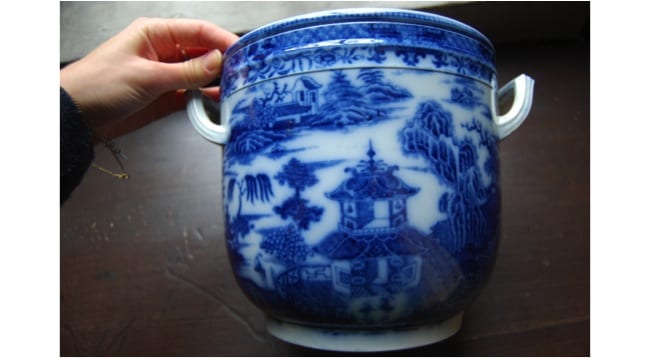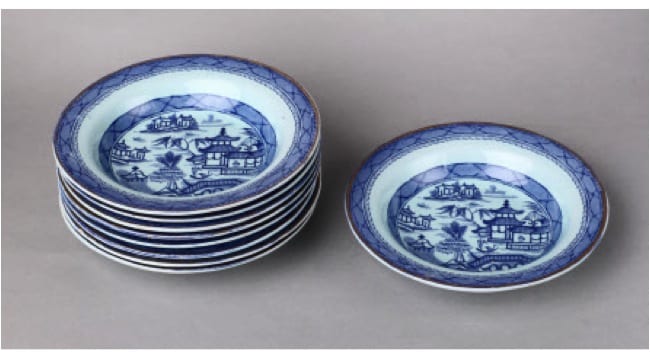
Figure 2. Willow Pattern plate, earthenware. Inventory number 929558.9. Dunham Massey, National Trust.(C) National Trust.
The Willow Pattern explained
Willow Pattern wares’ popularity and ubiquity in Britain meant that in their purchase, they invited consumers to engage with a particular form of collective British identity. Technological advancements in transfer printing in England in the 1750s, made the production of these wares possible. Transfer printing allowed ceramic decoration to be completed in large-batch productions, resulting in reduced prices for consumers and the increased possibility of standardized decoration.[1] Within these developments, the Willow Pattern emerged as a particularly popular image, becoming immediately recognizable to contemporary audiences and consumers in the early nineteenth century. The collective ‘ignorance’ of Chinese motifs amongst the majority of consumers allowed for a shared appreciation for Willow Pattern’s representation of ‘China’.Not bound to social class, its popularity meant that the Willow Pattern became a visual signifier of ‘British’ belonging across the country.[2]
Plates such as the one illustrated above (see figure 2) were produced in bulk, by factories such as Spode, Wedgwood, Worcester, Caughley, Liverpool, Lowestoft, Bow, New Hall, Coalport, Vauxhall and Derby. This particular plate illustrates the ‘Willow III’, which became known as ‘Standard Willow Pattern’ as a result of its pervasive presence in the late eighteenth and nineteenth century English ceramic market. The elements of the ‘Standard Willow Pattern’ include: an orange tree, a main tea house sided by a smaller building, a fence adorning the foreground, a willow tree, a bridge with three persons crossing it, a boat, an additional building on a separate shore and two birds occupying the central upper section of the ware. The engraving technique used on ‘Standard Willow Pattern’ or ‘Willow III’, which saw the combination of both line work and stipple punch work, further differentiated this version form previous patterns (‘Willow I’ and ‘Willow II’). By using a steel punch, which was struck with a lightweight hammer, different tonal qualities could be achieved by hammering single dots with diversified depths into the copper plate. Variations of the design existed but ‘Standard Willow Pattern’ is the one most commonly represented on wares and the one still in production today. The fact that this Willow Pattern was still sold in 2012 by Argos, the largest general goods retailer in the UK, attests to its enduring appeal.

Figure 3. Willow Pattern dinner set. Earthenware, transfer-printed in underglaze blue. Sold at Argos in 2012. (argos.com).
The original 1790 Willow Pattern can be understood as an attempt by British manufacturers to fabricate an idyllic far-away place, loosely understood as Chinese. The tragic love narrative, now understood as an important part of the Willow Pattern, was a later innovation and acted as a crucial part of the pattern’s success. As noted by Robert Copeland in an interview with Deborah Skinner in 2008, the addition of the bridge by the Spode factory in 1810 provided the grounds on which to build the love story narrative.[3] The bridge, absent from the original 1790 Caughley design, came to be one of the central components of the Willow Pattern story. The story that emerged during the nineteenth century described the three men crossing the bridge as servants chasing the king’s daughter, who had eloped with her lover. Objecting to his daughter’s amorous choice, the king tries to stop her at all costs.[4] In 1849 the Family Friend published the first article that showcased the Willow Pattern story entitled ‘The Story of the Common Willow Pattern Plate’. It was this publication which contextualised the pattern for contemporary audiences, disseminated the narrative further.
As the article title suggests the pattern was deemed a ‘common’ item. Similarly the preamble included within the article itself worked to strongly associate the pattern with sentiments of comfort and familiarity. Written less than sixty years after its first production, the preamble to the article described it as the ‘old Willow Pattern plate’, marking its confirmed place within British tastes. It then went on to describe how ‘By every association, in spite of its want of artistic beauty, it is dear to us. It is mingled with our earliest recollections; it is like the picture of an old friend and companion whose portrait we see everywhere, but of whose likeness we never grow weary.’[5] By establishing the design as a familiar visual agent, appreciated beyond its aesthetic value, the pattern became part of the reader’s intimate possessions, which constituted private, valued memories. At a later stage, the article also indirectly confirmed the myths that circulated around the design: its Chinese origins. Defining the tale as one, ‘which is said to be to the Chinese, what our Jack the Giant Killer or Robinson Crusoe is to us’, the article attributed authenticity to the story. Utilising all the elements within Spode’s ‘standard’ willow, ‘The Story of the Common Willow Pattern Plate’ helped ‘Willow III’ to be recognized as sentimentally British and simultaneously Chinese.

Figure 4. Two chamber pots bearing the ‘Flying Pennant’ pattern. Dunham Massey, National Trust. Image courtesy of Francesca D’Antonio.
It is not possible to explain why ‘Willow III’ gained its primary position among the range of Chinese landscape patterns on offer. It is also not possible to attribute the pattern to a specific factory and identify one production line to be significantly more prolific in the production of ‘Standard Willow Pattern’ than others. Although Spode was one of the top ten factories manufacturing blue and white earthenware, it cannot be stated with certainty that it was the main distributor of the ‘Standard Willow Pattern’. It may however be likely, that various other factories quickly copied the ‘Standard Willow Pattern’, to which Spode claimed authorship, multiplying its impact on the market.[6] As noted by Elizabeth Chang, however, ‘different firms developed their own variations, and further, these variations were pillaged from firm to firm with great regularity as patterns were frequently abandoned in favour of more fortuitous combinations of the standard elements’.[7] Some of these variations can be seen in the Willow Patterns wares included in the Dunham Massey collection. Within the collection are wares, which closely resemble ‘Flying Penant’, ‘Rock’, ‘Parasol Figure’ and ‘Two Temples’ patterns. Two chamber pots in the collection (see figure 4) include an illustration in the bottom interior of the wares that stems from a ‘Flying Penant’ engraving. Corresponding borders have been used to decorate the mouth of the pots. In contrast, the wine cooler in the collection (see figure 5) features the ‘Rock’ pattern with a slightly altered, yet recognisable corresponding border. At the same time, nine breakfast bowls (see figure 6) include an interpretation of the ‘Parasol Figure’ pattern.[8] Lastly a plate in the Dunham Massey collection (see figure 7) closely resembles the ‘Two Temples’ pattern. The fence present in the foreground characterises this design. This detail together with the holistic composition of land, water, bridge, pagoda and surrounding vegetation aligns the ware to this specific pattern.[9] ‘Rock I’ for example was made as a copy of the ‘Mandarin’ pattern, changing only in its border design. The border of ‘Rock I’ can furthermore be noted to exist in ‘Forest Landscape I’ and ‘Forest Landscape II’. It is important to acknowledge that the ubiquity of the pattern was created through the propagation of its variations. The demand for an exotic, imaginative landscape was so diffused that the composition of designs could be easily adapted without jeopardizing sales. The composition of the ‘Standard Willow Pattern’ became marginal to its popularity, as the public’s familiarity with the design allowed for its variations to function similarly in its place.

Figure 5. Wine cooler bearing the ‘Rock’ pattern. Dunham Massey, National Trust. Image courtesy of Francesca D’Antonio.

Figure 6. Nine breakfast bowls bearing the ‘Parasol Figure’ pattern. Dunham Massey, National Trust. © National Trust.

Figure 7. Plate bearing the ‘Two Temple Pattern’. Inventory number 929497. Dunham Massey, National Trust. © National Trust.
[1] Stacey Loughrey Sloboda, Making China: Design, Empire, and Aesthetics in Britain, 1745-1851 (Ann Arbor: UMI Microform, 2004) p. 314.
[2] Kathleen Wilson, Island Race: Englishness, Empire and Gender in the Eighteenth Century (London: Routledge, 2003) p. 3; Sloboda, Making China, p. 315.
[3] Deborah Skinner, ‘Robert Copeland On Spode’, Spode Ceramics (August 2008). [Accessed 5 Oct. 2012] <http://spodeceramics.com/pottery/printed-designs/patterns/willow-02>. Robert Copeland was an employee of Spode as of 1949 until his retirement. His father was Gresham Copeland, partner of the family-owned Spode factory.
[4]To read the full story visit: http://www.thepotteries.org/patterns/willow_patt.html.
[5] Robert Copeland, Spode’s Willow Pattern (London: Studio Vista, 1999), p. 198. See Appendix IX: J.B.L. “The Story of the Common Willow-Pattern Plate.” The Family Friend 1 (1849), pp. 198-201
[6]Copying often occurred in the ceramics industry through the circulation of workers, designs and expertise.
[7] Chang, Britain’s Chinese Eye, p. 87.
[8]The ‘Parasol Figure’ border has in this case not been adopted, as the border that encloses the design on the Dunham Massey bowls is made to complement the interior’s simplicity. Two basic geometric borders frame the minimal interior illustration.
[9]In this case the border is consistent with the engraving identified as ‘Two Temples’.